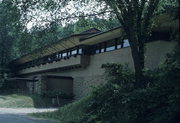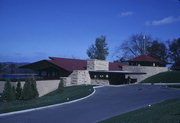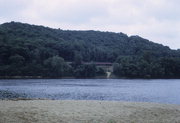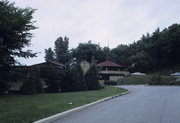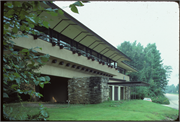Property Record
5607 CTH C
Architecture and History Inventory
| Historic Name: | Spring Green Restaurant |
|---|---|
| Other Name: | Taliesin Visitor Center/Wisconsin River Terrace & Restaurant, Riverview Terrace |
| Contributing: | |
| Reference Number: | 28741 |
| Location (Address): | 5607 CTH C |
|---|---|
| County: | Iowa |
| City: | |
| Township/Village: | Wyoming |
| Unincorporated Community: | |
| Town: | 8 |
| Range: | 4 |
| Direction: | E |
| Section: | 30 |
| Quarter Section: | NE |
| Quarter/Quarter Section: | NE |
| Year Built: | 1967 |
|---|---|
| Additions: | 1970 |
| Survey Date: | 19762018 |
| Historic Use: | restaurant/supper club |
| Architectural Style: | Usonian |
| Structural System: | |
| Wall Material: | Stone - Unspecified |
| Architect: | FRANK LLOYD WRIGHT; TALIESIN ASSOCIATES |
| Other Buildings On Site: | |
| Demolished?: | No |
| Demolished Date: |
| National/State Register Listing Name: | Spring Green Restaurant |
|---|---|
| National Register Listing Date: | 2/8/2024 |
| State Register Listing Date: | 11/17/2023 |
| National Register Multiple Property Name: |
| Additional Information: | A 'site file' exists for this property. It contains additional information such as correspondence, newspaper clippings, or historical information. It is a public record and may be viewed in person at the State Historical Society, Division of Historic Preservation. DESIGNED IN 1953 BY WRIGHT; ALTERED AFTER HIS DEATH BY TALIESIN ASSOCIATES. 2018 The Wisconsin River Terrace & Restaurant for Taliesin Fellowship, currently the Taliesin Visitor Center, was designed in 1953 and constructed in 1957 by Frank Lloyd Wright and Taliesin Associates in the Usonian style. It is a two-story building constructed into a hill and sits on a large lot with a circular driveway and parking lot. It is clad in masonry and stucco and covered by an irregular roof that has shallow gable, flat, and circular components; all are clad with asphalt shingles. The main entrance faces southeast and features a large masonry chimney, masonry planter, and three masonry pillars with recessed glass entrance doors. At the center of the building is a tall, circular wing with a large, decorative metal ornament at the center of the roof. Windows are generally fixed. A small addition was constructed on the west side of the building in 1969. Several modern signs are also located on the property. Frank Lloyd Wright was born in Richland Center, Wisconsin, in 1867 and went on to become one of the preeminent American architects of the twentieth century. By 1911 Wright had begun the construction of his primary Wisconsin residence, Taliesin, and continued to develop the property until his death in 1959. Wright designed the Taliesin Visitor Center in 1953, which he called the “‘gateway’ to Taliesin.” (1) According to Taliesin Preservation: “Wright designed the building to overlook the Wisconsin River, and intended it to serve as a restaurant and meeting room for his potential clients.” (2) The building was not completed until after his death. It currently serves as the Visitor Center for the Taliesin estate and houses a bookstore, café, and offices. |
|---|---|
| Bibliographic References: | WISCONSIN STATE JOURNAL 6/2/1994. 2018 (1) “Frank Lloyd Wright Visitor Center: Gateway to Taliesin,” https://www.taliesinpreservation.org/visit/fllw-vc (2) “Frank Lloyd Wright Visitor Center: Gateway to Taliesin,” https://www.taliesinpreservation.org/visit/fllw-vc |
| Wisconsin Architecture and History Inventory, State Historic Preservation Office, Wisconsin Historical Society, Madison, Wisconsin |

